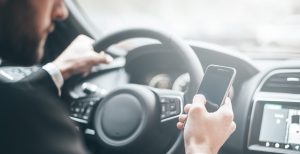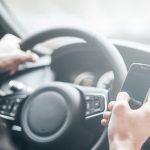The purpose of the law
To ensure safety on the roads and to protect other road users. Looking at or using your mobile phone whilst driving is distracting and prevents you fully concentrating on the road ahead.
The old law
It was an offence to use your mobile phone for performing an interactive communication function. This led to some usage being excluded as the legislation failed to keep up with technology. The use of a mobile phone to undertake an internal function such as taking pictures or being used as a camera was not captured by the old law so the Government saw the need to tighten up the terminology to ensure road safety.
The new law
On 25th March 2022 new Regulations were introduced that gave a specific definition of ‘using’ which includes :-
- illuminating the screen
- checking the time
- checking notifications
- unlocking the device
- making, receiving or rejecting a phone or internet based call
- sending, receiving or uploading oral or written content
- sending, receiving or uploading a photo or video
- utilising camera, video or sound recording
- drafting any texts
- accessing any stored data such as documents, books, audio files, photos, videos, film, playlists, notes or messages
- accessing an application which means any software programme that runs through a web browser or offline on a mobile phone
- accessing the internet
When does the law apply
This includes :-
- when you are driving;
- queuing in traffic;
- supervising a learner driver.
Exceptions
You can use a device held in your hand if you need to dial 999 or 112 in an emergency and it is unsafe or impractical to stop.
You are safely parked with the engine switched off.
You are making a contactless payment, for a good or service that is received at the same time as, or after, the contactless payment is made and your vehicle is stationary e.g at a drive through restaurant or road tolls. It does not cover the payment of more general types of online payment whilst driving.
Using devices hand-free
You can use a device with hands-free access as long as you do not hold it at any time during usage.
This includes using:
- a Bluetooth headset;
- a voice command;
- a built-in satnav.
Penalty
The offence may be dealt with by way of a fixed penalty notice whereby you complete a form, send off your driving licence and pay £200.00 unless you are at risk of a penalty points ban or the police choose not to use their discretion.
If the matter goes to court, you will face a fine of up to £1,000, victim surcharge and costs and 6 penalty points or a discretionary disqualification. The fine is up to £2,500.00 if you are driving a lorry or a bus.
Why did the law change
Using a mobile phone whilst driving is distracting and can lead to other people on the roads being killed, seriously injured or slightly injured. The fact that mobile devices have become capable of performing many more tasks beyond interactive communication meant the old law was out of date and necessitated a more prescriptive approach to the meaning of ‘using’ a mobile phone.
Prevention
The temptation will always be there to pick up your phone if it is next to you and you do not have a hands fee facility. The following may help deter you :-
- Switch your phone off
- Keep it out of reach
- Put it in your glovebox
- Use driving mode or do not disturb
- Thoughts of the consequences of the penalty which could include large monetary penalties, higher insurance premiums, if you are a new driver revocation of your licence and if you already have 6 points on your licence you will be at risk of a minimum 6 month driving and it could be even longer if you have had a previous ban.
To be safe do not pick up your phone at all whilst you are driving unless you fall under one of the exceptions.
Maria Moore
Moore Motoring Law
22.1.23






